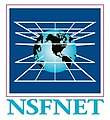American projects to promote computer research
| Internet history timeline
|
|
Early research and development:
Merging the networks and creating the Internet:
Commercialization, privatization, broader access leads to the modern Internet:
Examples of Internet services:
- 1989 (1989): AOL dial-up service provider, email, instant messaging, and web browser
- 1990 (1990): IMDb Internet movie database
- 1994 (1994): Yahoo! web directory
- 1995 (1995): Amazon online retailer
- 1995 (1995): eBay online auction and shopping
- 1995 (1995): Craigslist classified advertisements
- 1995 (1995): AltaVista search engine
- 1996 (1996): Outlook (formerly Hotmail) free web-based e-mail
- 1996 (1996): RankDex search engine
- 1997 (1997): Google Search
- 1997 (1997): Babel Fish automatic translation
- 1998 (1998): Yahoo Groups (formerly Yahoo! Clubs)
- 1998 (1998): PayPal Internet payment system
- 1998 (1998): Rotten Tomatoes review aggregator
- 1999 (1999): 2ch Anonymous textboard
- 1999 (1999): i-mode mobile internet service
- 1999 (1999): Napster peer-to-peer file sharing
- 2000 (2000): Baidu search engine
- 2001 (2001): 2chan Anonymous imageboard
- 2001 (2001): BitTorrent peer-to-peer file sharing
- 2001 (2001): Wikipedia, the free encyclopedia
- 2003 (2003): LinkedIn business networking
- 2003 (2003): Myspace social networking site
- 2003 (2003): Skype Internet voice calls
- 2003 (2003): iTunes Store
- 2003 (2003): 4chan Anonymous imageboard
- 2003 (2003): The Pirate Bay, torrent file host
- 2004 (2004): Facebook social networking site
- 2004 (2004): Podcast media file series
- 2004 (2004): Flickr image hosting
- 2005 (2005): YouTube video sharing
- 2005 (2005): Reddit link voting
- 2005 (2005): Google Earth virtual globe
- 2006 (2006): Twitter microblogging
- 2007 (2007): WikiLeaks anonymous news and information leaks
- 2007 (2007): Google Street View
- 2007 (2007): Kindle, e-reader and virtual bookshop
- 2008 (2008): Amazon Elastic Compute Cloud (EC2)
- 2008 (2008): Dropbox cloud-based file hosting
- 2008 (2008): Encyclopedia of Life, a collaborative encyclopedia intended to document all living species
- 2008 (2008): Spotify, a DRM-based music streaming service
- 2009 (2009): Bing search engine
- 2009 (2009): Google Docs, Web-based word processor, spreadsheet, presentation, form, and data storage service
- 2009 (2009): Kickstarter, a threshold pledge system
- 2009 (2009): Bitcoin, a digital currency
- 2010 (2010): Instagram, photo sharing and social networking
- 2011 (2011): Google+, social networking
- 2011 (2011): Snapchat, photo sharing
- 2012 (2012): Coursera, massive open online courses
- 2016 (2016): TikTok, video sharing and social networking
|
The National Science Foundation Network (NSFNET) was a program of coordinated, evolving projects sponsored by the National Science Foundation (NSF) from 1985 to 1995 to promote advanced research and education networking in the United States.[1] The program created several nationwide backbone computer networks in support of these initiatives. It was created to link researchers to the NSF-funded supercomputing centers. Later, with additional public funding and also with private industry partnerships, the network developed into a major part of the Internet backbone.
The National Science Foundation permitted only government agencies and universities to use the network until 1989 when the first commercial Internet service provider emerged. By 1991, the NSF removed access restrictions and the commercial ISP business grew rapidly.[2]
